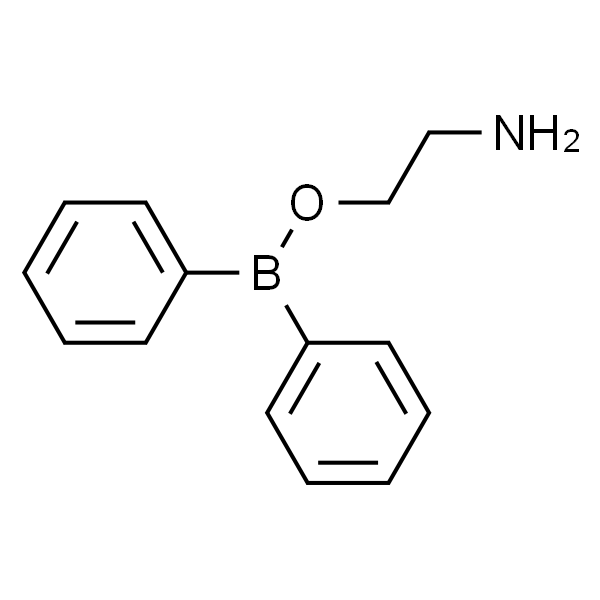| CAS |
524-95-8 |
| Chinese Name |
2-氨基乙基联苯基硼酸酯 |
| English Name |
2-Aminoethyl Diphenylborinate |
| Synonyms |
二苯基酸;2-APB;2-Aminoethoxydiphenyl borate |
| Molecular Formula |
C14H16BNO |
| Molecular Weight |
225.09 |
| Solubility |
Soluble in DMSO ≥5mg/mL |
| Purity |
≥98% |
| Appearance |
White to off-white Solid |
| Storage |
Powder:-20℃,2 years;Insolvent(Mother Liquid):-20℃,6 months;-80℃,1 year |
| EC |
EINECS:208-366-5 |
| MDL |
MFCD00014823 |
| SMILES |
B(C1=CC=CC=C1)(C2=CC=CC=C2)OCCN |
| InChIKey |
BLZVCIGGICSWIG-UHFFFAOYSA-N |
| InChI |
InChI=1S/C14H16BNO/c16-11-12-17-15(13-7-3-1-4-8-13)14-9-5-2-6-10-14/h1-10H,11-12,16H2 |
| PubChem CID |
1598 |
| Target Point |
IP3R;Calcium Channel;TRP Channel |
| Passage |
Membrane Transporter&Ion Channel;Neuronal Signaling |
| Background |
2-Aminoethyl Diphenylborinate is a cell-permeable IP3R inhibitor, inhibits store-operated Ca2+ (SOC) channels, and activates some TRP channels (V1, V2, and V3). |
| Biological Activity |
2-Aminoethyl diphenylborinate (2-APB) is a cell-permeable inhibitor of IP3R. 2-Aminoethyl diphenylborinate also inhibits the store-operated Ca2+ (SOC) channel and activates some TRP channels (V1, V2 and V3)[1-3]. |
| In Vitro |
2-APB dose-dependently induced a [Ca(2+)]i increase and dopamine release,which were greatly enhanced by the external acidification(pH 6.5). [Ca(2+)]i and secretory responses to 2-APB at pH 6.5 were inhibited by the removal of extracellular Ca(2+)and SOC channel blockers such as SK&F96365,La(3+)and Gd(3+). PC12 expressed all SOC channel molecules,Orai 1,Orai 2 and Orai 3. When we used an siRNA system,downregulation of Orai 3,but not Orai 1 and Orai 2,attenuated both [Ca(2+)]i and secretory responses to 2-APB. These results suggest that 2-APB evokes external acid-dependent increases of [Ca(2+)]i and dopamine release in PC12 through the activation of Orai 3. [3] |
| In Vivo |
Autologous arterial blood injection into the cisterna magna caused vasospasm in rats. 2-APB treatment increased the BA wall thickness and reduced the BA lumen diameter,inducing significant vascular changes. 2-APB also alleviated cell apoptosis at 24 hours after SAH.In experimental SAH in rats,2-APB treatment increased the BA wall thickness and reduced the BA lumen diameter,inducing significant vascular changes. 2-APB also alleviated cell apoptosis at 24 hours after SAH.[2] |
| Animal Experiment |
We performed an experimental study using 32 Sprague-Dawley rats divided into 4 groups: sham group(n = 8),SAH group(n = 8),2-APB group(SAH rats intraperitoneally administered with 0.5 mg/kg 2-APB; n = 8),and 2-APB-2 group(SAH rats intraperitoneally administered with 2 mg/kg 2-APB; n = 8). The rats were sacrificed after 24 hours,and superoxide dismutase,glutathione peroxidase,malondialdehyde,tumor necrosis factor-α,and interleukin-1β in the brain tissue and serum were measured. The histopathological investigation of brain tissue included measurement of the luminal diameter and wall thickness of the basilar artery(BA),and apoptotic cells in the hippocampus were counted after caspase staining.[2] |
| Data Literature Source |
[1]. Ma S,et al. Effect of Wilforine on the Calcium Signaling Pathway in Mythimna separata Walker MyocytesUsing the Calcium Imaging Technique. J Agric Food Chem. 2019 Nov 27.
[2]. Boyac MG,et al. Effects of 2-Aminoethyl Diphenylborinate,a Modulator of Transient Receptor Potential and OraiChannels in Subarachnoid Hemorrhage: An Experimental Study.
[3]. Takahashi K,et al. Molecular mechanism of 2-APB-induced Ca2 influx in external acidification in PC12. Exp Cell Res. 2014 May 1;323(2):337-45. |
| Unit |
Bottle |
| Specification |
10mg 25mg |


 English
English
 中文
中文

 Manual Download
Manual Download

